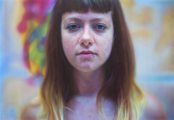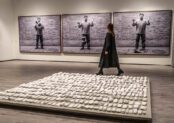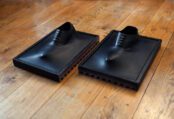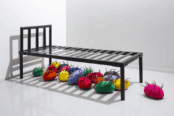Dara Birnbaum was one of the first artists to use television against itself. She took the passive nature of 20th-century media consumption and used it to tell a meta story about our lives as viewers.
Television gives us the archetypes and strategies through which we can achieve our ends. Reality TV is particularly normative in that within a set context we are shown what values and assumptions are successfully paid out in terms of salacious sexual conquests or cash prizes for the winner, as ‘decided’ by the public. Little wonder then that a public so trained is changing how politics works; after all, the modus operandi is the same.
TV programmes us. Which isn’t to say that we aren’t able to answer back but by being the vehicle for our imaginations it dictates where we can go. Artists like Dara Birnbaum are so effective because they bring us closer to the nuts and bolts of television as a social mechanism.
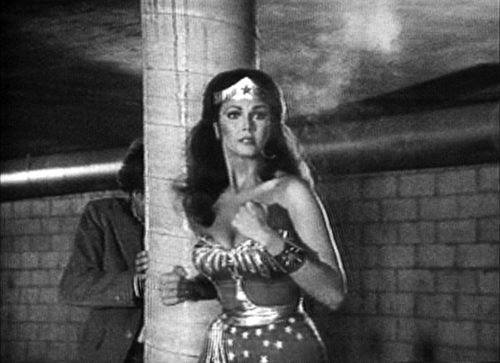
How have you taken existing images like Wonder Woman and made them your own?
Well, I’m getting older and that goes back aways (laughs). Video is not something I came upon immediately. I first did architecture and then I got into painting— I kind of slid into painting and art school. I read from Manfredo Tafuri, who was a great architectural critic and historian who thought that television actually was the architecture of the day (1970s). It interested me very much that television was such a dominant force. When I started, according to the Nielsen ratings the average American family was watching over six hours of TV a day. Therefore, I thought it was the most common language in the United States. I wasn’t very pleased with a lot of the imagery coming across on television. So I felt like pushing back against it. But it was very difficult because the medium was coming one way at us—it was very hard to penetrate the system. Being younger and being more angry,I learned how to meet people, like men in the industry, who would help me sneak out the footage from production studios, as there was no cable TV or anything similar.
So you couldn’t record broadcasted material? You stole the footage out of television production studios?
Exactly.
One would imagine that you just press a record button on a VCR?
Well, you’re younger than me. It was not easy back then. That’s why I’m saying, it was difficult to do this at the time. Television was the dominant medium coming into American homes. The question was how do you disrupt that pattern? Or how do you capture those images? The very first work I did in 1977 Lesson Plans: To Keep the Revolution Alive which was when I started to show my work for the first time. The piece was meant to break down the language of television. That was exhibited at Artists Space.
After that, I thought the medium should be turned on itself. Remember, this was the time of the Pictures Generation that I was part of, a group of artists in New York during the ‘70s who were changing the medium, concentrating on mass media, taking it and appropriating it, deconstructing it by putting it into other forms. But I thought the most important thing was to use this medium on itself, not to translate or transfer it.
You’ve mentioned the idea of language? How do you consider language?
We use words because that’s what we have. But questioning is something different. It’s not labelling, it is exploring the ways humans communicate. When I started, television was that language, which nowadays is very different for younger people. I’ve heard that some younger people hardly even know how to relate to television and what it is.
I think when you first confront something that’s systematised as a dominant institution, such as television has been, the impulse of an artist may be a questioning, or a wish to fight back against it. For example, with Wonder Woman, I grew up with that portrayal and I did not like the stereotyping of women in that way. In that phantasmagorical sense of either you’re an average secretary or you turn around three times and through a special effect become a Wonder/super woman. I resented that because it set up an idealised version of a representation of woman that I could never be.
I felt squeezed between two opposite dualities: the secretary or lawyer or whatever, who’s normalized within a construct or institution is certainly one thing, and taking on the role of a superheroine is another. Watching this formulation become number one on TV, I was struck as that’s not exactly how life is. However, many people still enjoy the idea, that idealisation, of projecting themselves onto a super being.
I have a friend who is much closer to the industry. And he speaks a slightly different language than me as an artist. When he watches TV, he looks for character portrayals. But to me, however, everything is encased in roles or stereotypes.
Is that what you’re playing with in your own work?
I was not playing, I was fighting! I was very determined to see how one artist could affect the way such images are portrayed and seen.
Were you part of the Guerrilla Girls movement?
No, but one day I was an honorary Guerrilla Girl. I helped them out technically on something. I was very honoured to be featured in a poster that said: ‘these are really the Guerrilla Girls. It portrayed four women who were known in the arts. And I’m one of them. But I’ve never been a Guerilla Girl per se.
Is that a full on denial for all time?
I loved what they were doing. I’m sympathetically a Guerilla Girl at heart. We had a great evening at one of the big clubs, the Palladium, where the Guerrilla Girls were doing an event. There were video walls that came down pneumatically into the dance space from the ceilings. It was very dramatic. We played some of my work, like Wonder Woman, on all 25-50 screens. I love some of the Guerilla Girl posters. In one poster, “The Advantages of Being a Woman Artist,” it stated “be reassured that whatever kind of work you make it will be considered feminine” which is a problem I still face.
What is the role of architecture in your work?
Some people have felt that the installations have a kind of architectonic feeling—that they can sense that the structure of the work, the embedding of video within the work’s structural elements, utilises space in a more unique way. Through most of my career I wanted to deal with the actuality of the exhibition spaces, and contour the works within that.
One direct example would be a piece like Hostage, which was about the kidnapping of Hanns Martin Schleyer. Screens were lined up very purposely with shooting targets, and to view the imagery, you would have to align yourself within this system of screens. Different aspects of these events, regarding the Baader Meinhof and Hanns Martin Schleyer, are related in each of the monitors. At the very end of this train of monitors, on two opposing walls, a laser shoots across the space connected both images of Hanns-Martin Schleyer forced to give a speech on television and US coverage of the event.
Now, if you choose to take a path to enter into this viewing arena, you get targeted. You break the laser relay and all images freeze:you become a target. As in Hostage many of my works have frequently tried to utilize historical touchstones and key markers of specific turning points or events. I incorporated such key elements to save them from the waves of culture. So that they could be resurrected when exhibited and thus allowed to speak for this history. I didn’t want these moments to get lost.
I was asked by a culture centre in Linz to do this work. They gave us a list of the topics that they were wanting artists to touch upon and the one that I chose from that list was Hanns Martin Schleyer .
Baudrillard wrote that he thought the RAF forcing Schleyer onto television, after his kidnapping to declare himself an enemy of the people was immensely important because it reinforced the power of television. This specific footage was, enormously difficult to get hold of to use in this work; perhaps it was intentionally buried. We went through about ten countries, mostly in Europe, to try to find the exact footage. We actually found it in England. England was the one that came up with it from a news gathering service. Schleyer’s family in Germany had asked that this footage never be shown. However, I felt that this was a very historically important televisual moment. Baudrillard said that when Schleyer’s speech went out on television, the power of that televised voice meant they didn’t need him anymore; he was soon killed thereafter.
The kidnapping and murder was in 1977 and I made the work in 1994. I don’t do well “close-up”—it is hard for me to deal with events when they’re happening. I want that distance in my work. In the actuality of things happening, they are overwhelming for me. Lately, I have done better, moving towards being on top of events while maintaining a distant point of view.
My mind was in a different place in ‘77. But in 1994, the event took on new meaning.Bear in mind, the first bombing of the World Trade Centre was in1993. For me there was a resonance of that in Hostage, that terrorism was coming to the United States. We were a seemingly isolated country—not that there weren’t other incidents but the idea of an external force being able to penetrate the US was important.Whereas, for example. Hanns Martin Schleyer, amongst other events, signified an important development in the rise of terrorism in Europe. A lot of people who are a little younger than me seemed to really enjoy the 90s here, but I found it a terrible period, politically, which eventually lead up to 9/11.
I live very close to where the World Trade Centre had been. My first experience was getting up in the morning to take the dog out. I heard on the radio that a plane had hit the World Trade Centre. I immediately didn’t feel good. I went to the television, and there you could see the first pictures. You could see the degree of the impact. Immediately it felt very, very bad. I went and looked downstairs. Many people were already gathered on Thompson Street, which had aligned directly with the World Trade Centre. One of the planes came down extremely low, using our street as a slight line.—almost like a runway. I took the dog and I went downstairs and I was in time to see the other plane coming, circling around back, then speeding up to hit. Now the strange thing is that, as an architect, I worked on the World Trade Centre. I worked on the architectural drawings, and I understood the structure of those buildings.I had a complete flashback of those drawings. I knew the towers were going to fall, that they were going to pancake. When the flames started to reach across the floors with that heat, I knew. The people on the street thought I was nuts because I was saying they’re going to fall. And they hadn’t yet. But I felt it, I felt it. It’s affected my whole life actually.
You picked up on something that I forgot that Hostage was. I would never gone with that Hanns Martin Schleyer idea if I hadn’t experienced that first bombing in the garage of the World Trade Centre. Many artists portrayed the second bombing of the World Trade Centre in various ways. And I could not do that. I have always seemingly needed some distance. If I see one more painting of the COVID-19 virus…
Would you say your work is about quotation?
Yeah, it is. One of my later works, Arabesque, quotes images of women playing that Robert Schumann piece on YouTube. At the time, no one was playing Clara Schumann’s work on that website. By appropriating these videos and taking them out of context, I am trying to redefine or reveal their underlying structure.
What’s the structure of feminism now?
I learned that it’s changing. I have a retrospective coming out in a year at the Hessel Museum of Art, CCS Bard, and for the catalogue, a committee recommended writers, including Legacy Russell. She’s much younger than me, and has recently come out with a book called Glitch Feminism. Her writing made me realise the meaning of feminism has shifted for a whole new generation. As an artist from a previous generation I never thought of my early work as feminist. But there I was.
When I was starting out in architecture and being the only woman in the class, I was very proud of it. But I don’t think of myself as a feminist but in doing that. I suppose I was but I didn’t take that on. I was at Carnegie Mellon University. I was the youngest person ever admitted to the architecture department at age 16, not just the youngest woman. We had a few women in this six year program, but in my year I was the only woman to graduate. But understand this, I was determined to do architecture. My mind wasn’t on being a feminist doing architecture.
Why? Was it doing the job?
It was the desire, same as I had by the time of Wonder Woman, it was a recognition of fighting back against stereotyping of women. I’ve also tried to take on the stereotyping of men, because it exists as well, such as in Kojak/Wang.Art, good art, great art comes from the heart. I can only speak, through my own voice and for what I think is relevant. Being a woman is who I am, but I think any good work of art shouldn’t be purely reflective of who I am, or am not—especially when that identity is then presented for an art market. Rather, if one has the talent to do art, no matter what medium, the work should be coming from a place where your talent services a community or a culture in a way that will eventually contribute to an understanding of how we’re living.

The aim of art is to represent not the outward appearance of things, but their inward significance. – Aristotle





